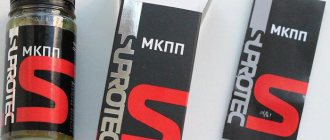Recommendations
Comments 52
The other day I also looked at gasoline passports. The numbers are still the same. Like they write as a carbon copy. A Tatneft gas station appeared in Maega, formerly Westmarket. Gasoline is still the same - Yaroslavsky 
This is how it should be) The equipment is the same, the personnel are the same, the processes are the same, the raw materials are the same. Why should the results be different?
95x Lukoil has a lower density than Slavneft. On Slavneft IMHO the acceleration is faster and the consumption is a little less. I checked it on two machines at different times. Although according to the passports the ethers in Slavneft are obtained, and Lukoil is cleaner and more honest. How so? Is it a little more powerful with oxygenate?
Yes, there is a difference in density of less than 1%. Oxygenates have a much lower calorie content than gasoline.
I mean, oxygenate can increase the speed and completeness of fuel combustion and thereby increase efficiency? Or is it within a few percent, which is difficult to catch with a popometer?
It’s difficult to say anything here; no one has conducted independent tests. All you have to do is either believe the advertising or rely on your own measurements.
Can I ask a couple of questions? How do you feel about acetone workers? Is it possible to make 95 from 92 with half a bottle of acetone? As a detergent additive, can Laurel, Liqui, Castrol in pure 95th replace 95th Ecto or Afton with something more multifunctional?
Acetone has a lower calorific value than gasoline, so it is better to pour 95 at once. I pour Lukoil 100 into my car. I tried acetone in a ratio of 25-50 ml per 10 liters. I didn't feel any improvement. And I have a strong feeling that we sell acetone of very low quality with a high water content. So I probably won’t pour any more. 95 ecto was poured into the previous car. Now I doubt the advisability of all these additives.
I also poured 200 ml per 40 l, I also didn’t feel anything
GPN writes who the manufacturer is, but LUKOIL does not write which refinery it takes from, only NB is indicated.
Volganefteprodukt is a Nizhny Novgorod oil refinery.
All this is strange, there is not a word about the Nizhegorodnefteorgsintez Refinery in the passport.
Can anyone explain the meaning of taking passport photos? They will always be “just right.” I’m not saying that gasoline is crap, but that it won’t be the same from batch to batch. And looking for the best is like waiting for weather by the sea.
It won't be absolutely the same. But it won’t be much different either. And the same presence or absence of MTBE can significantly affect the feeling of the car’s dynamics.
Do you think these unfortunate 2 tenths of a percent in Yanosov gasoline have any effect?
Two tenths of a percent of what? Yaroslavsky 95 added 2.5% of the volume of MTBE.
I looked around. Okay, is the presence of 2.5% methyl tertiary butyl ether a serious presence?
Caloric content of gasoline is 44000-46000 MJ/kg Caloric content of MTBE 35200 MJ/kg Both have a density of 0.74 kg/liter That is. in 40 liters of gasoline with 2.5% MTBE, the calorific value will be 200-230 ml less of pure gasoline.
This volume is equal to 15 minutes of engine operation at xx. The bullshit is shorter.
Caloric content of gasoline is 44000-46000 MJ/kg Caloric content of MTBE 35200 MJ/kg Both have a density of 0.74 kg/liter That is. in 40 liters of gasoline with 2.5% MTBE, the calorific value will be 200-230 ml less of pure gasoline.
and the fractional composition of onions, unlike Janos, is not optimal, see the World Gasoline Charter, so these 200-230 ml will sink into suboptimal engine performance, and the gearbox is secondary.
Gazprom Neft stopped production of 92 and 95 gasoline
Independent traders confirmed that due to repairs to the cat cracking unit at the Moscow Oil Refinery, the supply of the most popular brands of gasoline AI-92 and AI-95 has actually ceased. As a result, demand for them in neighboring regions doubled. If repairs take longer, market participants predict an increase in fuel prices. There is no talk of a deficit yet - the Ministry of Energy says that it controls the situation, and the accumulated reserves are enough to prevent a collapse.
At the end of June, Reuters, citing several sources in Gazprom Neft and in the industry, reported an accident at the Moscow Refinery: a catalytic cracking unit failed. The company officially denied this information, but later announced a “short-term technological shutdown of catalytic cracking in the second ten days of July.” In the schedule of refinery repairs published by the Ministry of Energy, preventive maintenance at the Moscow plant does not appear.
However, independent market operators say they are already experiencing problems with purchasing gasoline. Gazprom Neft has practically stopped selling AI-92 and AI-95 gasoline, said Dmitry Kozhukh, Deputy General Director and Commercial Director of the Trassa Group of Companies. According to him, the situation has led to an increase in demand for gasoline in the Moscow and surrounding regions, including at the Trassy oil depot in Elektrougli. “The supply of petroleum products there has increased by 80% both to independent fuel companies and to vertically integrated oil companies,” he says. Company experts predict that if gasoline production is not resumed within the stated time frame, then the increase in demand will be followed by an increase in prices for petroleum products, which is already observed on the electronic platforms of St. Petersburg International Trading Exchange and International International Trading Market. Over the past week, the maximum increase in exchange prices for gasoline was 800 rubles. per ton.
“It is important for us that Gazprom Neft fulfills all its obligations,” says one of the participants in the oil products market. — Negotiations are ongoing on this issue. The company is unlikely to be able to supply the market with gasoline in full, but the main thing is that Gazprom Neft’s own sales should not have priority over independent companies.” Another interlocutor says that gasoline from other manufacturers has already risen in price by 2000-2500 rubles. per ton. “The question is not that there is no gasoline at all, but that it is not available at factory prices,” he notes. According to him, repairs to the installation at the Moscow plant are scheduled for the period from July 6 to July 18.
A Gazprom Neft representative said on Friday that the installation was operating normally as of July 6. Previously, the company reported that the plant was considering the possibility of a planned short-term technological shutdown of the catcracking unit in the second ten days of July. In this case, a slight decrease in the production of AI-92 and AI-95 gasoline will not affect the supply of petroleum products to the Moscow region market and, if necessary, will be replenished with reserve volumes of fuel available at the Moscow Refinery, as well as with supplies of petroleum products produced by other company plants.
The Ministry of Energy stated that the situation with the supply of petroleum products to the Moscow market is stable, predictable and has no prerequisites for a shortage. The slight reduction in production volumes associated with repair work at the catalytic cracking unit is not significant for the Moscow region and is fully covered by supplies of petroleum products from refineries in other regions. “Currently, the Moscow region has accumulated significant fuel reserves that fully satisfy market demand, and are: AI-92 - 12 days, AI-95 - 9 days, diesel - 9 days,” the ministry reported.
Russian vertically integrated oil companies are ready to help Gazprom Neft with gasoline, but they say that the company has not made them an offer to purchase fuel. “If Gazprom Neft turns to LUKOIL, we will be able to help them,” said a LUKOIL representative. According to him, the company will provide its own gas stations in the Moscow region with petroleum products supplied from the Nizhny Novgorod refinery. “If the company needs support, we will do everything possible to supply the Moscow market with gasoline,” said Amir Feyzulin, First Deputy Executive Vice President for Refining and Trade at TNK-BP. Rosneft refrained from commenting.
According to the Cortes IAC, since the beginning of the month Gazprom Neft has not supplied gasoline to the stock exchange; only TNK-BP, Bashneft, Surgutneftegaz and Belarusian refineries have traded. Anticipating possible problems with the supply of fuel from the Moscow refinery, oil traders are trying to stock up on gasoline, and the limited supply of it leads to rising prices, notes Pavel Strokov, director of strategic development at Cortez. If necessary, Gazprom Neft can buy petroleum products from other vertically integrated oil companies directly or through the exchange, so there will not be a serious shortage of gasoline or an increase in prices on the Moscow market in the near future, the expert is sure.
The Moscow Refinery (Moscow, Kapotnya district) annually processes up to 10.5 million tons of oil, producing over 2.8 million tons of gasoline and 2.7 million tons of diesel fuel. The processing depth is at least 73.1%
Content
Today, at gas stations you can often find fuel called G Drive 95. Gazpromneft introduced the innovative fuel to the company and successfully sells it at its own gas stations. According to the manufacturer, the new gasoline is premium and can significantly increase the performance and service life of the vehicle. The G drive fuel mixture has already appeared at most gas stations in the capital and St. Petersburg. Gradually, G drive fuel is becoming widespread and will soon be available at gas stations in any region. Some car enthusiasts have already tried and appreciated high-tech gasoline. For everyone else, the new gasoline is of great interest and raises many questions. Let's talk about the main parameters of the new motor fuel and identify its characteristic differences compared to more common analogues.
Gasoline G-Drive. What it is?
This type of fuel is produced in several types: the most accessible is 95, although 98 and even 100 are also offered. The difference is that each manufacturer develops and uses strictly defined additives in the production of “its” gasoline. Thus, with the same octane number, for example, 95, Ecto-95 gasoline from Lukoil, V-power from Shell, Pulsar gasoline, etc. can freely coexist.
The composition and content of additives are not disclosed in advertising, so consumers have to, as they say, “play in the dark.” However, by going to the websites of global additive manufacturers, you can find that G Drive 95 uses KEROPUR 3458N from the famous German chemical concern BASF and Afton Hites 6473 with a friction modifier from Afton Chemicals. The advantages declared by the brand were achieved on cars of a certain manufacturer (Volkswagen), moreover, having a direct fuel injection system.
For a comparative assessment of efficiency, G-Drive fuel was tested on cars with other engine characteristics - small-displacement, turbocharged, etc. Acceleration dynamics were assessed using a high-precision VBOX Mini recorder, which guarantees the accuracy and reproducibility of the experimental results. Information was obtained from the engine speed and the relative position of the throttle valve. The engine's sensitivity to this type of fuel during acceleration in different gears was also determined. The changes in power were recorded using a dynamometer. After refueling, the engine was given some time necessary to adapt to the new type of fuel.
The test results were as follows:
- On cars with power up to 110 hp. an increase in both torque and engine power was established, with a corresponding decrease in start inertia.
- Engine thrust increases when it is equipped with a direct fuel injection system.
- Additives that determine the efficiency of G Drive 95 gasoline can be added independently, following the recommendations of the relevant manufacturer. The resulting fuel will fully comply with the Euro-5 class, and its characteristics will be close to 98 grade gasoline.
- G-Drive fuel reduces the intensity of carbon deposits on the spark plugs, and other engine parts become significantly less dirty. Engine power and torque increase due to a reduction in unproductive losses due to mechanical friction.
The additives described are absolutely harmless, and you can work with them while observing the usual precautions.
ECTO, Pulsar, G-DRIVE, V-POWER - what is it?
ECTO, Pulsar, G-DRIVE, V-POWER - these and many other names have combinations of additives that are added by manufacturers to gasoline to improve its properties. Each manufacturer has its own patented formula of additives that should improve the quality of work.
note
The cost of gasoline with additives is always higher than the cost of the regular version of fuel. On average, the price of fuels with additives is 1-2 rubles higher than regular gasoline.
Many car enthusiasts know that in specialized stores you can buy special additives that need to be added to the fuel tank after refueling to clean the injector, valves, nozzles, increase power, and reduce fuel consumption. In fact, gasoline with additives is fuel in which a similar solution has already been diluted.
Advantages and disadvantages. Analyzing reviews
Car owners note that real G-Drive fuel can only be refueled at gas stations from Gazprom Neft (at franchise gas stations the authenticity of this fuel is not guaranteed).
The main conclusions that can be drawn by summing up the rating of fuel in user reviews:
- G-Drive gasoline is neither bad nor good in itself. Its declared advantages (according to the general opinion of the majority of car owners who write reviews about this type of fuel) are somewhat overstated, although the overpayment per liter is not so great.
- The effectiveness of G-Drive depends on the brand of car: for example, what is noticeable on a Suzuki, imperceptible on a Toyota, etc. Which is understandable - leading car manufacturers do not calculate the characteristics of installed engines for a specific brand of fuel, but are guided by general principles - durability, reliability, efficiency.
- The additives contained in the type of fuel in question allow, to some extent, the dissolution of the resins contained in gasoline, and are not completely removed from its composition due to the peculiarities of the technological process (and, mainly, due to the insufficiently strict current quality standards).
- The choice in favor of G-Drive gasoline is due and justified for those motorists who have purchased new equipment and are filling their car with this gasoline for the first time. If the car has been refueled with another type of fuel for quite a long time, then a lot of time may pass for the additives to take effect, during which no significant improvements in the car’s performance may occur.
- The use of G Drive (regardless of the brand) is noticeable only with frequent changes in the vehicle's driving mode, in which it is the acceleration time that is important. For large cities with eternal traffic jams, the use of this fuel is ineffective.
- It is better to match gasoline to the engine than to match the engine to gasoline.
The main differences between G - drive 95 and more common types of fuel mixture.
Taking into account the above, we can note a number of worthy advantages of the new fuel composition over previously used analogues. For those who are more interested in the new composition of the fuel mixture, an obvious question arises - why is the new composition so different from the usual gasoline for the better? Let's talk about some of the tricks that the developers used when making the new composition.
As already mentioned, the first thing that distinguishes the new generation fuel from regular gasoline is the presence of a whole complex of active additives. When developing fuel, manufacturers used the latest additives, which can significantly increase the performance and service life of the engine. In addition to improving the technical characteristics of the vehicle, the new composition made it possible to achieve reliable protection of the vehicle from premature wear.
The main advantages of G-drive 95 over regular gasoline.
A special component that prevents increased friction of the working parts of the internal combustion engine made it possible to increase the technical characteristics of the vehicle when using a new gasoline composition. As a result, the car began to operate more smoothly and productively.
Using the new composition allows you to achieve:
1. Increase motor power from 10 to 12%. The special component included in the G Drive fuel allows you to reliably protect the working components of the propulsion system from increased friction. Thus, the manufacturer managed to achieve an increase in engine power and improved acceleration dynamics of the vehicle.
2. Increase in vehicle acceleration dynamics by 1.5 seconds. Due to the fact that the friction of the working parts of the engine has decreased, the vehicle has increased its dynamic characteristics.
3. Reliable protection of components of the most important vehicle systems from premature wear. The complex of active additives contains a special component that helps reduce the formation of plaque on injectors. Thus, the new fuel allows you to preserve the factory parameters of the propulsion system for a long time and increase the service life of the vehicle. There already, G Drive 95 allows you to increase the performance of a car with high mileage. Anti-corrosion additives contained in new gasoline can reduce the cost of repair and maintenance of internal combustion engines.
4. Noticeable savings on fuel costs. Due to the fact that the use of the new composition reduces friction of the working components of the propulsion system, the consumption of the fuel mixture is significantly reduced. In addition, the new composition helps reduce harmful impurities in exhaust gases.
All of the above-described improvements in vehicle performance were confirmed by testing the new mixture on various vehicles.
The production process of the new composition differs in many ways from the previously used one. Today, gasoline undergoes multi-stage testing before release, which allows achieving maximum results. The majority of modern cars from well-known brands - Volvo, Volkswagen, Ford and Fiat - were tested. Manufacturers of modern vehicles have confirmed the productivity of the new fuel mixture.
New gasoline allows you to improve vehicle performance from the very beginning of use. After long-term use of G Drive 95, vehicle owners note an improvement in the performance of the propulsion system and a more uniform and clear function of the car.
One of the criteria for checking any fuel composition is real reviews from car owners. Today, a considerable number of car owners have been able to test the productivity of the new fuel composition.
Despite a number of qualitative changes in the operation of the vehicle, confirmed by testing on the most popular car brands, reviews from car enthusiasts about the new G Drive 95 are ambiguous.
Some vehicle owners confirm improvements in the performance of the car’s propulsion system since the beginning of the use of G Drive. Some car enthusiasts who swapped their usual 95-octane gasoline for G-drive were able to note improvements in acceleration dynamics and increased engine power.
The rest of the car enthusiasts managed to notice the differences between the G Drive and the usual 95 after passing a certain amount of mileage. A possible reason for this may be the high wear and tear of the engine system components due to the high mileage.
Despite the richer composition of the new fuel, the price of G Drive is not much different from the common AI - 95. You can find the innovative fuel composition at most gas stations. The complex of active additives is of great interest among car enthusiasts, and the affordable price of fuel allows testing for every car owner.
According to the manufacturer, the composition of the new fuel mixture will be refined and enriched with new components to improve engine performance.
The productivity of the new composition can only be checked through personal use. Perhaps the use of G-drive will actually increase the maximum mileage of the car and reduce repair and maintenance costs. The more gentle and economical operation of the engine was confirmed by the majority of car owners. Already today, a considerable part of car owners refuel exclusively with G-drive. It is possible that G-drive will be the beginning of a new era of fuel compositions that make cars more economical and environmentally friendly.











